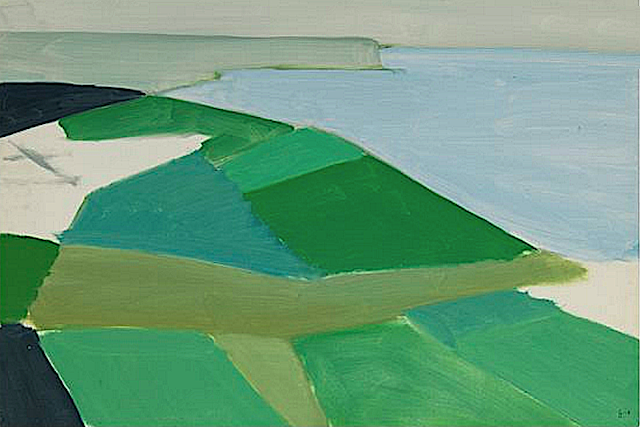
NICOLAS DE STAËL (1914-1955),
Montagne Sainte Victoire (1, 011m )
France Provence)
In ciel de Vaucluse, huile sur toile, 16 x 24 cm, 1953, Collection privée
A propos de cette toile
Titré "Ciel de Vaucluse" on a supposé qu'il s'agissait d'une évocation de la Montagne Sainte-Victoire, hommage à Cézanne que Stael admirait beaucoup, bien que cette montagne ne se trouve pas dans le Vaucluse mais dans les Bouches du Rhône. La logique voudrait qu'il s 'agisse du Mont Ventoux, mais la silhouette de montagne évoquée ici rappelle définitiveent plus la Sainte Victoire que le Ventoux !
La montagne
La montagne Sainte-Victoire (1, 011m ) en provençal Mont Venturi selon la norme classique ou Mount Ventùriselon la norme mistralienne, est un massif calcaire dans la région Provence-Alpes-Côte d'Azur. Située à l'est d'Aix-en-Provence, elle a connu une notoriété internationale en partie grâce aux 87 œuvres du peintre Paul Cézanne dont elle est le sujet. Elle accueille de nombreux randonneurs, grimpeurs et amoureux de la nature, et elle est un élément majeur du paysage aixois.
Le massif de la Sainte-Victoire s'étend sur 18 kilomètres de long et sur 5 kilomètres de large10, suivant une stricte orientation ouest-est. Il se situe principalement dans le département des Bouches-du-Rhône et en partie dans celui du Var, et, avec ses abords, sur les communes de Puyloubier, Saint-Antonin-sur-Bayon, Rousset, Châteauneuf-le-Rouge, Beaurecueil, Le Tholonet, Vauvenargues, Saint-Marc-Jaumegarde, Pourrières, Artigues et Rians. Les D 10 et D 17 (Route Cézanne) sont les principales routes qui permettent de longer le massif. Sur le versant septentrional, la D10 franchit le col de Claps (530 m) et le col des Portes (631 m). Sur le versant méridional, la D 17 chemine sur le plateau du Cengle et franchit le collet Blanc du Subéroque (505 m). Le massif culmine au pic des Mouches (1 011 m pour l'IGN), près de l'extrémité est de la chaîne, et non pas à la Croix de Provence (946 m pour l'IGN) proche de l'extrémité ouest et visible d'Aix. Le pic des Mouches est l'un des plus hauts sommets du département des Bouches-du-Rhône, après le pic de Bertagne qui atteint l'altitude de 1 042 mètres13 et qui se situe sur le massif de la Sainte-Baume. 6 525 ha du massif de la Sainte-Victoire sont classés depuis 1983.
Le Peintre
Nicolas de Staël (prononcé [stal) baron Nikolaï Vladimirovitch Staël von Holstein (Николай Владимирович Шталь фон Гольштейн), est un peintre français originaire de Russie, issu d'une branche cadette de la famille Staël von Holstein. La carrière de Nicolas de Staël s'étale sur quinze ans, de 1940 à sa mort. Artiste prolifique, il réalise au cours de sa carrière 1120 tableaux aux influences diverses — Cézanne, Matisse, Van Gogh, Braque, Soutine et les fauves, mais aussi les maîtres néerlandais Rembrandt, Vermeer et Seghers. Sa peinture est en constante évolution. Des couleurs sombres de ses débuts (Porte sans porte, 1946 ou Ressentiment, 1947), elle aboutit à l'exaltation de la couleur comme dans le Grand Nu orange (1953). Ses toiles se caractérisent par d'épaisses couches de peinture superposées et un important jeu de matières, passant des empâtements au couteau (Compositions, 1945-1949) à une peinture plus fluide (Agrigente, 1954, Chemin de fer au bord de la mer, soleil couchant, 1955). Refusant les étiquettes et les courants, tout comme Georges Braque qu'il admire, il travaille avec acharnement, détruisant autant d’œuvres qu'il en réalise. Nicolas de Staël meurt à 41 ans en se jetant de la terrasse de la maison où il avait son atelier à Antibes. Cette maison fut classée monument historique en mars 2014. Il est enterré au cimetière de Montrouge. Par son style évolutif, qu'il a lui-même qualifié d'« évolution continue », il reste une énigme pour les historiens d'art qui le classent aussi bien dans la catégorie de l'École de Paris, que dans les abstraits ayant inspiré les jeunes peintres à partir des années 1970, ou encore dans la catégorie de l'art informel. Il a maintes fois créé la surprise notamment avec la série Les Footballeurs, entraînant derrière lui des artistes d'un nouveau mouvement d'abstraction et les artistes du néo-formalisme new-yorkais, ou de l'expressionnisme abstrait de l'École de New York, parmi lesquels se trouve notamment Joan Mitchell.
_________________________________________
2023 - Wandering Vertexes ....
Errant au-dessus des Sommets Silencieux...
Un blog de Francis Rousseau
,%201954%20oil%20on%20canvas%2088.3%20x%20129.5%20cm%20Private%20collection.jpg)




